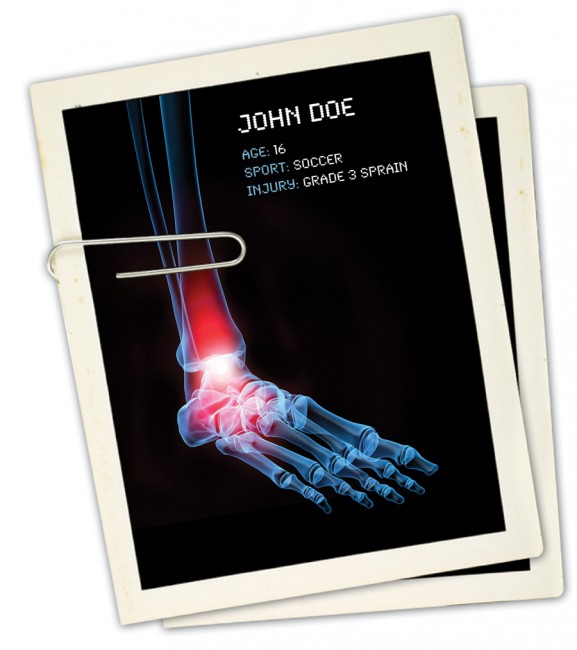A sprained ankle is a very common injury for teens — athletes and non-athletes alike. It happens when the ligaments that support the ankle get overly stretched or torn. Sprained ankles can happen when you step in a hole, slip walking downhill or just put your weight down on your foot awkwardly.
Some sprained ankles are minor injuries that heal with little treatment. Others can be more serious, though. The three grades of ankle sprains, based on how much damage is done to the ligaments, are:
- Grade 1. This is a mild sprain where ligaments stretch slightly. Someone with a grade 1 sprain will feel some soreness and may notice a bit of swelling.
- Grade 2. This is a moderate sprain where ligaments tear partly, making the ankle joint feel loose. The ankle will feel painful, and may stay swollen for a while. Putting weight on the foot can be difficult.
- Grade 3. This is the most severe kind of sprain, where an ankle ligament tears completely. The ankle joint will be very painful, with quite a bit of swelling. The person’s ankle will feel loose and unsteady and early on the person probably won’t be able to put any weight on the ankle.
How Do I Know if I Have a Sprain?
If your ankle hurts enough after an injury that you need to call a doctor, the office staff will probably ask questions over the phone about how you injured it and what it feels like. They may give you advice on treating the injury by yourself.
If your doctor wants you to come in for an office visit, he or she will examine your ankle to see which ligaments have been injured. This involves moving your foot in various ways to check for stability and determine the grade of the sprain. You may also need to get X-rays to see if any bones are broken.
In rare cases, an ankle sprain involves a severe injury to the ligaments or joint and your doctor may order an MRI to evaluate the injury in more detail.
What Causes a Sprained Ankle?
Most ankle sprains happen when people turn or twist too fast and too far or when the foot rolls onto its side, injuring the ligaments that connect the ankle and leg bones. You don’t have to be playing hard to injure an ankle: Sprains can happen just from taking an awkward step or tripping on the stairs.
The most common type of sprained ankle is called an inversion sprain, or lateral ligament sprain. With this type of sprain, the ankle turns so the sole of the foot is facing inwards, stretching and possibly damaging the ligaments on the outer part of the ankle.
When you turn your ankle the other way, so that the sole of the foot is facing outward, this is called a medial ligament sprain. This damages the ligaments on the inside of a person’s ankle. Medial ligament sprains are fairly rare.
If you repeatedly sprain the same ankle or feel pain for more than four weeks, you may have what’s called a chronic sprain. This type of lasting sprain can flare up and be made worse by activities that involve rolling or twisting the feet, like running, dancing or playing sports.
Can I Prevent a Sprained Ankle?
It’s impossible to prevent all ankle sprains. But everyone can take precautions to make sprains less likely.
The best way to prevent ankle sprains is keeping your ankles flexible and your leg muscles strong. Your coach, doctor or PE teacher can give you some easy at-home exercises to build muscle strength (which protects ligaments) and joint flexibility.
Here are some other ways to protect yourself against ankle sprains:
- Always warm up and use the recommended stretching techniques for your ankles before playing sports, exercising, or doing any other kind of physical activity.
- Watch your step when you’re walking or running on uneven or cracked surfaces.
- Don’t overdo things. If you’re tired or fatigued, it can make an injury more likely. Slow down, stop what you’re doing or take extra care to watch your step when you’re tired.
- If you’ve had a sprained ankle in the past, make sure it’s completely healed before you try any strenuous physical activities.
- Using tape, ankle braces or high-top shoes may be helpful if you’re prone to ankle sprains.
- Get good shoes that fit your feet correctly, and keep them securely tied or fastened when you’re wearing them. Speaking of shoes, one of the biggest causes of ankle sprains in women is wearing high-heeled shoes.
What’s the Treatment For a Sprained Ankle?
Treatment for a sprained ankle depends on the grade of the sprain. Most sprains heal within four to six weeks if you protect your ankle well and follow your doctor’s instructions.
Some things you can do to help a sprained ankle include:
- Use the RICE formula as soon as possible after the injury: Rest. Limit the amount of walking you do, and try to avoid putting weight on your ankle if your doctor recommends this. Ice. Use a bag of ice or cold compress to help reduce swelling for the first 48 hours after the injury. This should begin as soon as possible after the injury and then every three to four hours for 20 to 30 minutes at a time until the swelling is gone. Compress. Your doctor may place your ankle in a splint, like an air splint or an elastic wrap. Follow instructions closely and don’t remove these until your doc says it’s OK. Elevate. When you are sitting or lying down, keep your leg elevated.
- Take anti-inflammatory medications. Ibuprofen and other non-steroidal anti-inflammatory drugs (NSAIDs) can help relieve pain and reduce swelling in the ankle.
- Avoid activities that put pressure on your ankle. Don’t play sports that require running, cutting, or stopping quickly until your doc says it’s OK. Don’t hike, jog or exercise on uneven surfaces until the ankle is properly healed.
- Do stretching and strengthening exercises. After the pain and swelling have improved, ask your doctor about an exercise program to improve your ankle’s strength and flexibility. Depending on the severity of the sprain, the doctor may recommend physical therapy to help the healing process.
More Serious Sprains
Grade 2 sprains will benefit from wearing an elastic bandage or an air splint (a cushioned plastic brace.) Grade 3 sprains require a splint or other firm device to help immobilize the ankle.
Even ankle ligaments that are completely torn can often heal on their own if they’re properly immobilized. On rare occasions, though, a sprained ankle may require surgery.
Doctors usually try immobilization and other treatments before recommending surgery. But if your doctor decides surgery is the best option, he or she may start with arthroscopy. This involves inserting a small camera device into the joint through a tiny cut. It allows the doctor to look inside the joint to see what’s going on — like if part of the ligament is caught in the joint or there are bone fragments in the joint — and treat it if necessary.
In very rare cases, doctors will recommend surgery to reconstruct a torn ligament. It’s unlikely that most teens will need this type of surgery for a sprained ankle, though. Your body will probably heal on its own as long as you don’t overdo it too quickly.
Not overdoing things is key when it comes to sprains. So follow your doctor’s advice and don’t push yourself or feel pressure to get back into sports or other activities too soon. Sprains usually heal well, but they need time to get fully better.
— This information was provided by TeensHealth, one of the largest resources online for medically reviewed health information written for parents, kids, and teens.
 High School Illustrated High School Sports Magazine
High School Illustrated High School Sports Magazine

